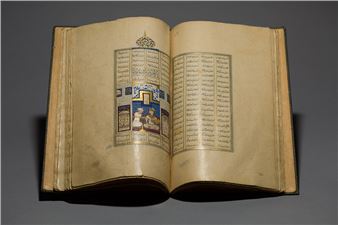Nick Santoro: Night of the Dobermanns
There’s a raw, unfiltered vitality pulsing through Nick Santoro’s latest exhibition, Night of the Dobermanns. With a visual lexicon that is both deeply Australian and eerily otherworldly, Santoro’s work plunges into the chaos of the everyday and drags up something ancient and mythical from beneath the surface. Part punk historian, part street poet, Santoro is less interested in polish than in the pulse—what it feels like to be in the fray of a suburban fever dream.
Santoro’s paintings are crowded, unruly, and immense. They teem with life: dogs, drunk figures, cigarette butts, discarded beer bottles, and endless references to pop culture. He doesn’t romanticise the chaos. He animates it and mythologises it. It’s a cacophony of iconography that spills out of his canvases in a way that feels almost biblical in scale. He’s spoken about his influences—comics, graffiti, Goya, and even The Simpsons—and it’s easy to see the connection. Santoro’s world is recognisably suburban: grubby, loud, cracked, and strange. And yet, he elevates it. The bar stool becomes a throne, the oval a shrine, the Horsch truck a chariot in a suburban epic. There’s poetry in this grime—a myth-making that feels essential in its honesty.
Calling him the “Hieronymus Bosch of the Suburbs” might sound flippant—until you stand in front of one of his larger works and feel its gravity. These are moral landscapes, not in a preachy sense, but in the way they catalogue humanity’s folly and absurdity with wit and precision. His paintings are visual parables, cautionary tales that present society’s vices not with moral judgment, but with understanding.
Like Bosch, Santoro offers a kind of moral map through the darkly surreal. But instead of the fantastical hellscapes of the 15th century, Santoro’s are set between Sydney and Wollongong: from the CBD to Marrickville, from Fairy Meadow to Balgownie. The pub crawl turns to pilgrimage, the street fight becomes fable. Santoro doesn’t offer answers or absolution, but recognition. We see ourselves in the mayhem.
This exhibition marks a particularly visceral chapter in Santoro’s practice. At its heart is a tension between threat and comedy; a pulsing duality. The drunk becomes the prophet, the vandal a hero, the greyhound is both witness and omen. Santoro captures what he calls “the tribalism of the night”—the transformation that occurs when the sun goes down and different rules take over. The titular dobermanns act as sentinels of this strange underworld. They stand in doorways and wait at the edge—the eyes of the street and the ghosts of the evening.
There are echoes of Pieter Bruegel in the way Santoro builds outwards—using tiny figures and incidental moments to construct grander scenes. Bruegel’s peasants stumble through carnivals and cautionary tales; Santoro’s figures linger around shopfronts and back fences, suspended between violence and humour, impulse and ritual. Bruegel had demons and angels; Santoro has feuding figures in Coogi sweaters. His chaos isn’t random, but complex—a tapestry of small truths that immerse us in the lived textures of the suburbs.

Recommended for you
There’s a raw, unfiltered vitality pulsing through Nick Santoro’s latest exhibition, Night of the Dobermanns. With a visual lexicon that is both deeply Australian and eerily otherworldly, Santoro’s work plunges into the chaos of the everyday and drags up something ancient and mythical from beneath the surface. Part punk historian, part street poet, Santoro is less interested in polish than in the pulse—what it feels like to be in the fray of a suburban fever dream.
Santoro’s paintings are crowded, unruly, and immense. They teem with life: dogs, drunk figures, cigarette butts, discarded beer bottles, and endless references to pop culture. He doesn’t romanticise the chaos. He animates it and mythologises it. It’s a cacophony of iconography that spills out of his canvases in a way that feels almost biblical in scale. He’s spoken about his influences—comics, graffiti, Goya, and even The Simpsons—and it’s easy to see the connection. Santoro’s world is recognisably suburban: grubby, loud, cracked, and strange. And yet, he elevates it. The bar stool becomes a throne, the oval a shrine, the Horsch truck a chariot in a suburban epic. There’s poetry in this grime—a myth-making that feels essential in its honesty.
Calling him the “Hieronymus Bosch of the Suburbs” might sound flippant—until you stand in front of one of his larger works and feel its gravity. These are moral landscapes, not in a preachy sense, but in the way they catalogue humanity’s folly and absurdity with wit and precision. His paintings are visual parables, cautionary tales that present society’s vices not with moral judgment, but with understanding.
Like Bosch, Santoro offers a kind of moral map through the darkly surreal. But instead of the fantastical hellscapes of the 15th century, Santoro’s are set between Sydney and Wollongong: from the CBD to Marrickville, from Fairy Meadow to Balgownie. The pub crawl turns to pilgrimage, the street fight becomes fable. Santoro doesn’t offer answers or absolution, but recognition. We see ourselves in the mayhem.
This exhibition marks a particularly visceral chapter in Santoro’s practice. At its heart is a tension between threat and comedy; a pulsing duality. The drunk becomes the prophet, the vandal a hero, the greyhound is both witness and omen. Santoro captures what he calls “the tribalism of the night”—the transformation that occurs when the sun goes down and different rules take over. The titular dobermanns act as sentinels of this strange underworld. They stand in doorways and wait at the edge—the eyes of the street and the ghosts of the evening.
There are echoes of Pieter Bruegel in the way Santoro builds outwards—using tiny figures and incidental moments to construct grander scenes. Bruegel’s peasants stumble through carnivals and cautionary tales; Santoro’s figures linger around shopfronts and back fences, suspended between violence and humour, impulse and ritual. Bruegel had demons and angels; Santoro has feuding figures in Coogi sweaters. His chaos isn’t random, but complex—a tapestry of small truths that immerse us in the lived textures of the suburbs.














